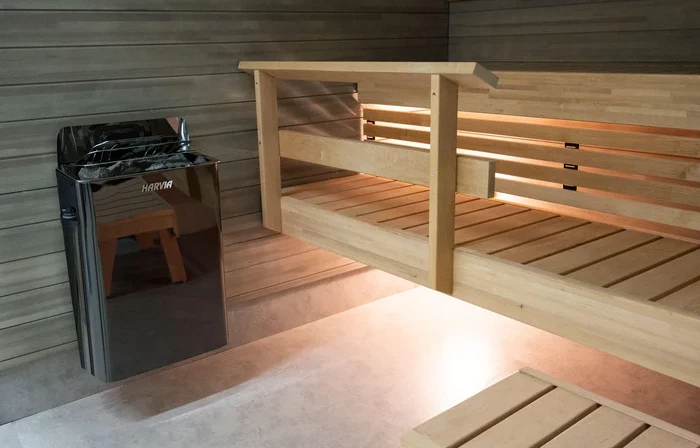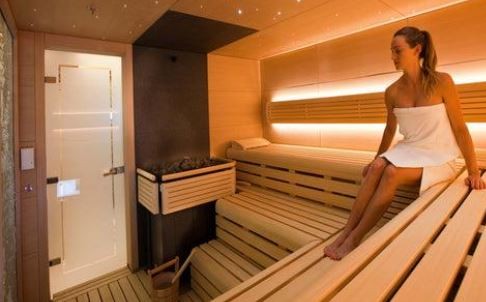YOUR COMPREHENSIVE GUIDE
TO A TRADITIONAL SAUNA
What is a traditional sauna? They are heated spaces where you can relax and unwind, and they offer a slew of other health benefits. Saunas are historically linked to the Finnish culture, where they played a major role for centuries. Bathers would relax in the saunas and start sweating to remove toxins and other impurities from the body.

To date, traditional saunas are still used, often found in high-end hotels and gyms. Weight lifters, athletes, and gym goers have often used saunas for post-workout recovery. Now, home saunas have been made accessible and are gaining in popularity so that everyone can enjoy the wealth of health benefits that they have to offer.
This guide will dive deeper into what a traditional sauna is, how it works, and its benefits.
What is a Traditional Sauna?
A traditional sauna is a wooden room or cabin that uses heated stones to create a dry environment where you can relax. You can heat the stones using a wood-burning, gas, or electric stove. Water is then poured over the hot sauna rocks to create steam. This is known as "loyly" by Finnish sauna enthusiasts.
Traditional saunas come in all sizes and shapes, from the standard indoor cabin to the popular outdoor barrel saunas. They can be built to accommodate anything from one to ten people, and sometimes even bigger. Most traditional saunas accommodate 1-4 individuals.
A traditional sauna works by heating the room's air, which heats your body. Traditional saunas operate at very high temperatures of between 160 to 194 degrees Fahrenheit.
Wood-Burning Sauna Heater
Most sauna fans prefer the wood-burning sauna heater for a traditional feel. It provides amazing sauna sessions due to its woody aroma and ambience. Wood-burning saunas use firewood to power the sauna heater. This makes it hard to first control the temperature in a wood-burning sauna. However, as you learn how the sauna works, it becomes easier to operate.

Electric Sauna Heater
Electric sauna heaters operates as well as the wood-burning type. Most uses 220V of electricity to heat your sauna stones. If you opt for this type, you'll need to place the sauna where you can wire it. In this case, you'll need the help of a licensed and professional electrician for the wiring process.

What is the Difference between a Wet and a Dry Sauna?
When it comes to a traditional sauna, it can be operated as both a “dry” sauna and a “wet” sauna. What makes it a “wet sauna” is simply pouring water over the rocks to create steam. Since the rocks are heated to extreme temperatures, the water vaporizes fast, forming steam. To enjoy a “dry sauna,” simply abstain from pouring water over the rocks to benefit from the dry heat.
Both wet and dry sauna experiences relieve stress and tension, help rejuvenate the skin through perspiration, and stimulate blood circulation. While a wet sauna will increase the temperature and humidity moreseo than a dry sauna, both will invoke sweating and provide benefits.

The heat in a dry sauna is more tolerable, and the actual impact on the body is better since the heat reaches the body directly, producing results more quickly. The body produces sweat creating humidity which means the body is still cooled, and the impurities and other toxins are eliminated in the same way as with a wet sauna.
Health Benefits of a Traditional Sauna
Spending time in a traditional sauna has many potential health benefits. As your body starts heating up, you start sweating, and your cardiovascular activity increases. These body changes can impact your body in several ways, outlined below:
Deep Relaxation
One of the main benefits of a traditional sauna is deep relaxation. When you spend time in a traditional sauna cabin's peaceful, relaxing, and warming environment, you'll enjoy deep relaxing sessions. Relaxation is arguably one of the best benefits of using a sauna. Traditional sauna sessions stimulate physical and mental relaxation that helps encourage better sleep and relieve anxiety. Many people use saunas to relax and unwind after a long and stressful day at work.
Authentic Feel
When most people think of a sauna, they immediately think of the heated sauna rocks and pouring water over them to create steam. It's not easy to beat the authentic feel of a traditional sauna as you kick back and unwind in the warmth of an authentic wooden sauna.
Workout Recovery
Traditional saunas are ideal for workout recovery. Suppose you're an athlete, a weight lifter, or a fitness enthusiast. In that case, a traditional sauna will be a great addition to your home. Finishing your workout sessions with a short sauna dip can help speed up muscle recovery. The deep penetrating heat of a traditional sauna can boost tissue healing, relax tired muscles, and relieve stiffness.

Cleansing the Skin
The sweat droplets help clean your skin as they pass through the pores. They carry grime and dirt to the skin's surface, where it can be washed away. Your skin will also glow as blood flow is brought to the skin's surface before you start sweating. Therefore, frequent sauna sessions make the skin more robust, implying it firms it up and make it more elastic, which is ideal for aesthetic reasons.
Improved Circulation
Any activity that increases your body temperature will increase your heart rate and circulation. Therefore, a traditional sauna session is just like working out on a treadmill at a regular pace. Due to the heat, your heart pumps harder to circulate your blood, which implies you're enjoying some cardio benefits.
Lowered Blood Pressure
Spending time in a sauna lowers your blood pressure. However, you should steer clear of a sauna if you have uncontrolled blood pressure. Regular traditional sauna bathing is linked to overall blood pressure. Like exercise, your blood pressure will increase, and in the long-term, it results in better blood pressure management and lowers it. Most sauna users realize improved cardiovascular health and lower risk of dementia, stroke, and heart attack.
Stress Relief
Traditional sauna bathing has been seen as a way of relaxing and distressing for ages. Saunas are known to reduce the stress hormone cortisol by around 10 to 40%, according to a 2018 research published in the journal Medical Principles and Practice.
Reduced Muscles Soreness and Joint Stiffness
Saunas are an ideal workout recovery tool as they help loosen up tense muscles after a workout. The heat from the sauna makes your muscles more elastic and pliable, helping with workout recovery and soreness. In addition, saunas help ease the pain of individuals with body aches and stiff joints. These sessions can also help with tension-type headaches, mainly because they eliminate the muscle soreness that causes them.
Improved Immune System
Traditional sauna bathing isn't ideally linked to improved immunity directly. However, sauna sessions reduce stress and relaxation, dampening immune system function. Study shows that sauna use decreases the circulating levels of inflammatory markers, which negatively affects your immune system response.
Improved Mood
Sauna sessions have improved your mood, which is tied to relaxation. Research also shows that men who often use saunas have a decreased risk of psychosis, Alzheimer's disease, and dementia.

Traditional Sauna Safety Precautions
To prevent the negative health effects of sauna use, the following precautions are advised:
Prevent Dehydration
When using a sauna, you must be careful to avoid dehydration. Sauna sessions improve your body temperatures triggering intense sweating, which leads to water loss from the body. You must replace this water to avoid dehydration. Therefore, it's advisable to drink water before starting your session and continue drinking water afterward. Avoid alcohol as it raises the risk of hypotension, dehydration, arrhythmia, and sudden death.
Limit the time spent in a sauna
Avoid spending more than 20 minutes at a time in your sauna. Beginners should spend a max of 5-10 minutes.
Avoid sauna use if ill
If you're ill, wait until you recover before using a sauna. Pregnant women or those with medical conditions like low blood pressure should consult their doctors before sauna use. Likewise, you should avoid using a sauna or consult your doctor if you have any of the following health issue:
-
Epilepsy
-
Heart disease
-
Breathing problems or asthma
-
Pregnancy
-
Extreme low or high blood pressure
General Care Tips for a Traditional Sauna
Like any other room in your house, you should regularly sweep or vacuum your sauna's interior to remove dirt and dust. Once a month or so, dip a brush or cloth in a bucket of warm water and wipe down the floor, backrests, walls, and benches. You can also use a mild dish detergent mixed with warm water or a specific sauna cleaner.
SIGN UP. SAVE BIG.
Subscribe to be the first to know about our special monthly sauna sales, sent right to your inbox.

Do this while the sauna is not operating. Moreover, after after sauna use, leave your sauna door open to release the accumulated steam and allow the excess moisture to clear out. Before beginning your sauna session, you should clean your feet to help remove potential sweat and dirt build-up. It's advisable to take a brief shower before and after, as well.
Why Floor Kits?
When it comes to indoor traditional saunas, many of them utilize your existing floor as the interior floor of your sauna. If your home’s floor is made of vinyl, concrete, laminate flooring, or tile, those will all work. Putting an indoor sauna on a carpet is not recommended. Still, you may want to protect your existing floor with an indoor floor kit. The indoor sauna floor kit is made with HemFir Limber and designed to fit in any traditional indoor sauna. These strong custom-fit parts are free-standing and can easily be installed in almost any traditional indoor sauna. They help create a cozier feel and look.
When it comes to barrel saunas, the floor will be slightly curved. If you prefer a level floor, you can use a barrel floor kit to modify it and make it flat.
Summary
A traditional sauna provides you with hours and years of calming steam therapy. You'll enjoy great health benefits, such as a stronger immune system, as you relax. One of the main benefits of installing a traditional sauna in your home is convenience. You, your family, and your friends will have 24/7 access to a sauna. Moreover, you can hop into your private sauna anytime. No more trekking to your local gym or spa. All you have to do is to flick a switch (or light some firewood) to allow your sauna to preheat before jumping in. Within a few minutes, you'll unwind and relax in your sauna without stepping outside your home.
We hope this comprehensive guide has helped you understand all that a traditional sauna is and what it can offer you. Take a look at all our collection of traditional saunas to find the best one for your home.